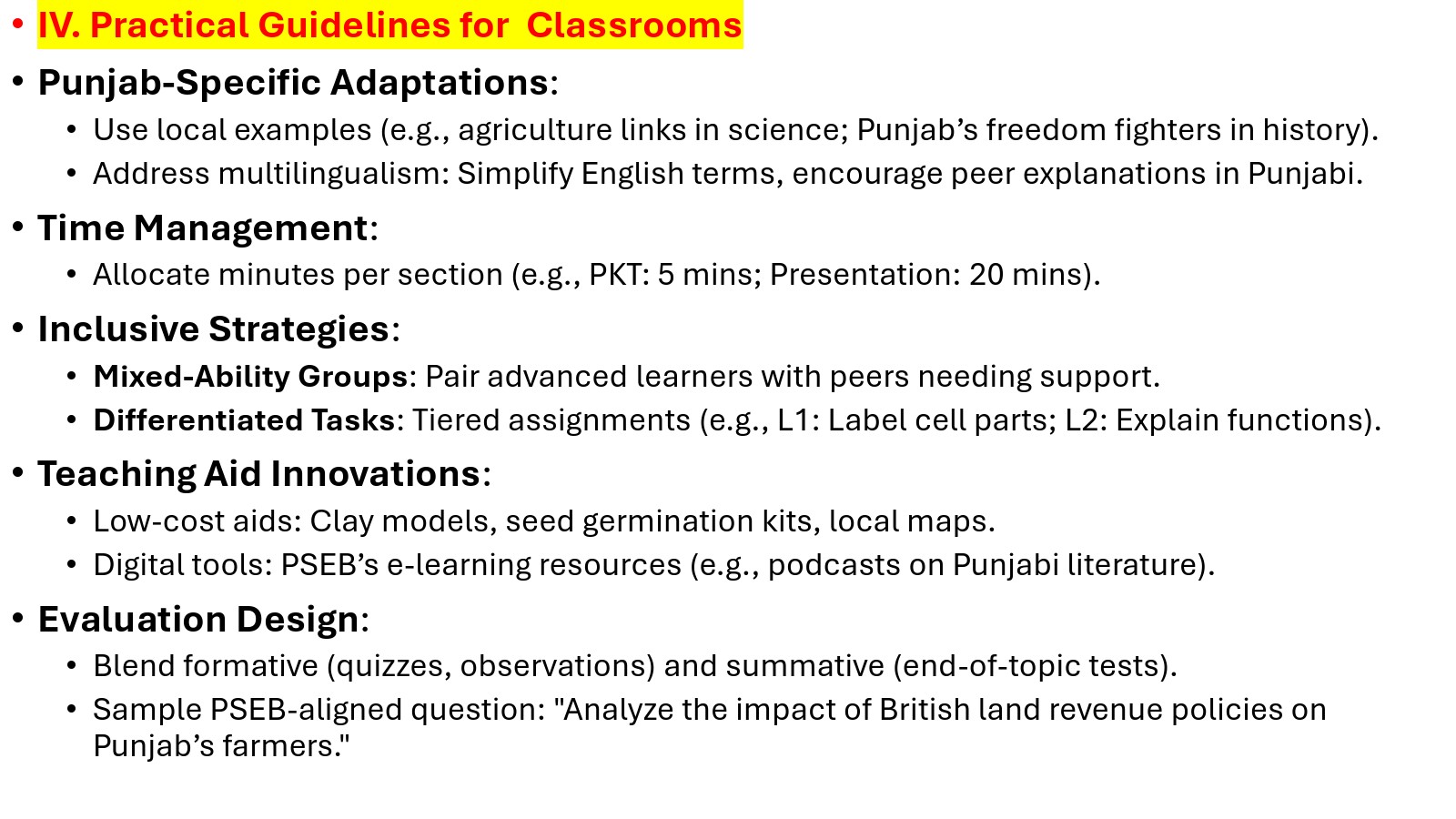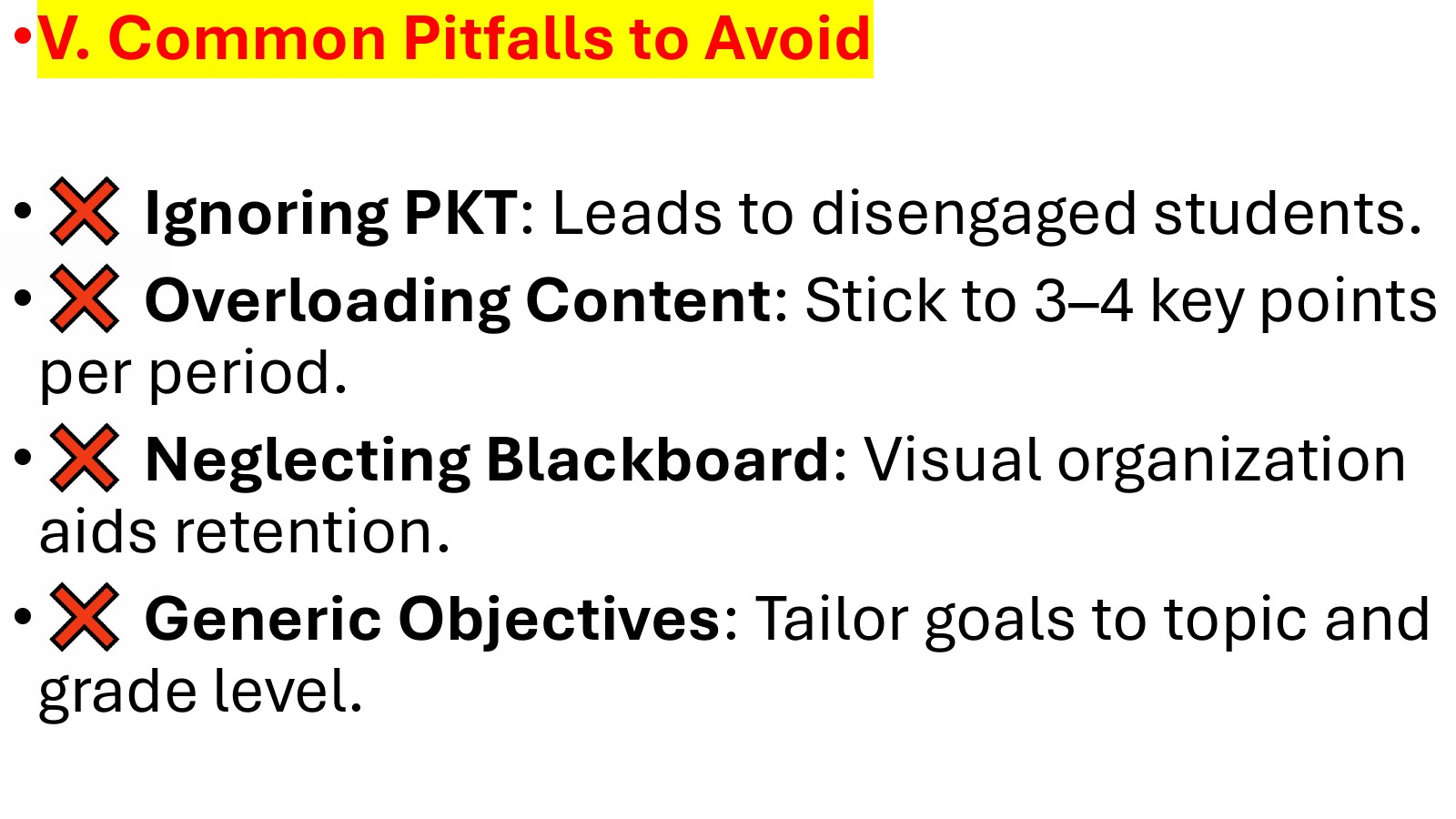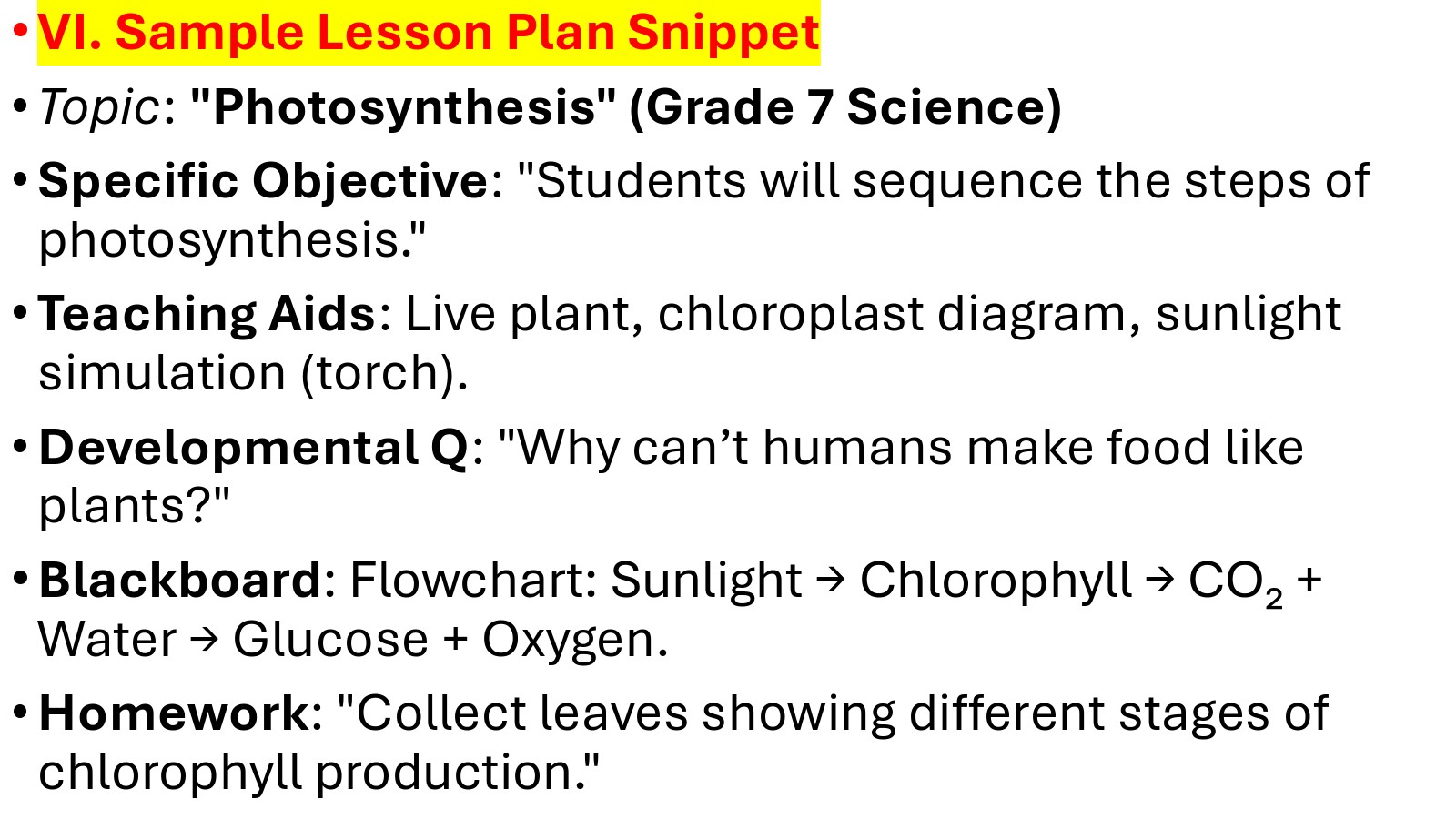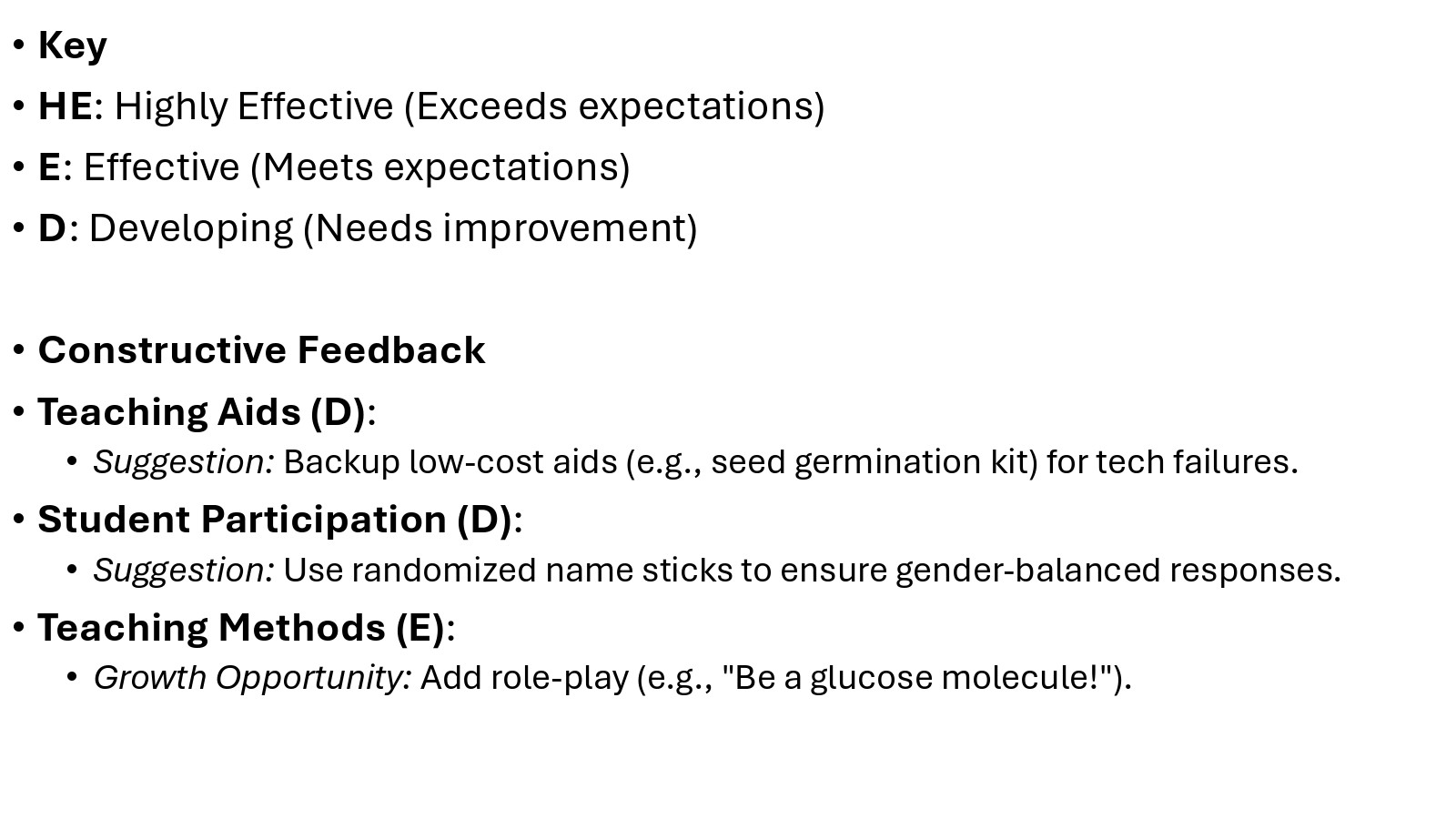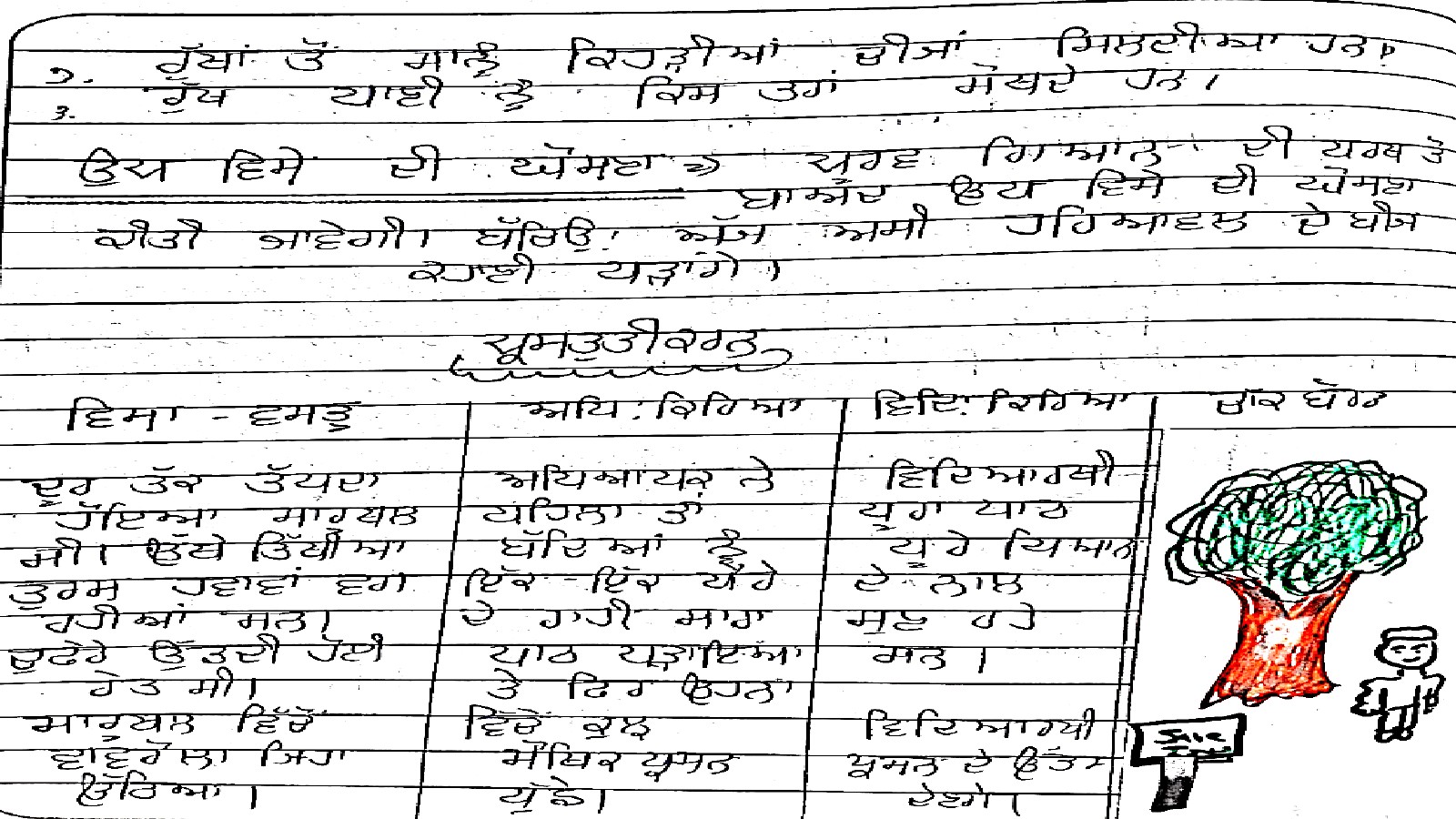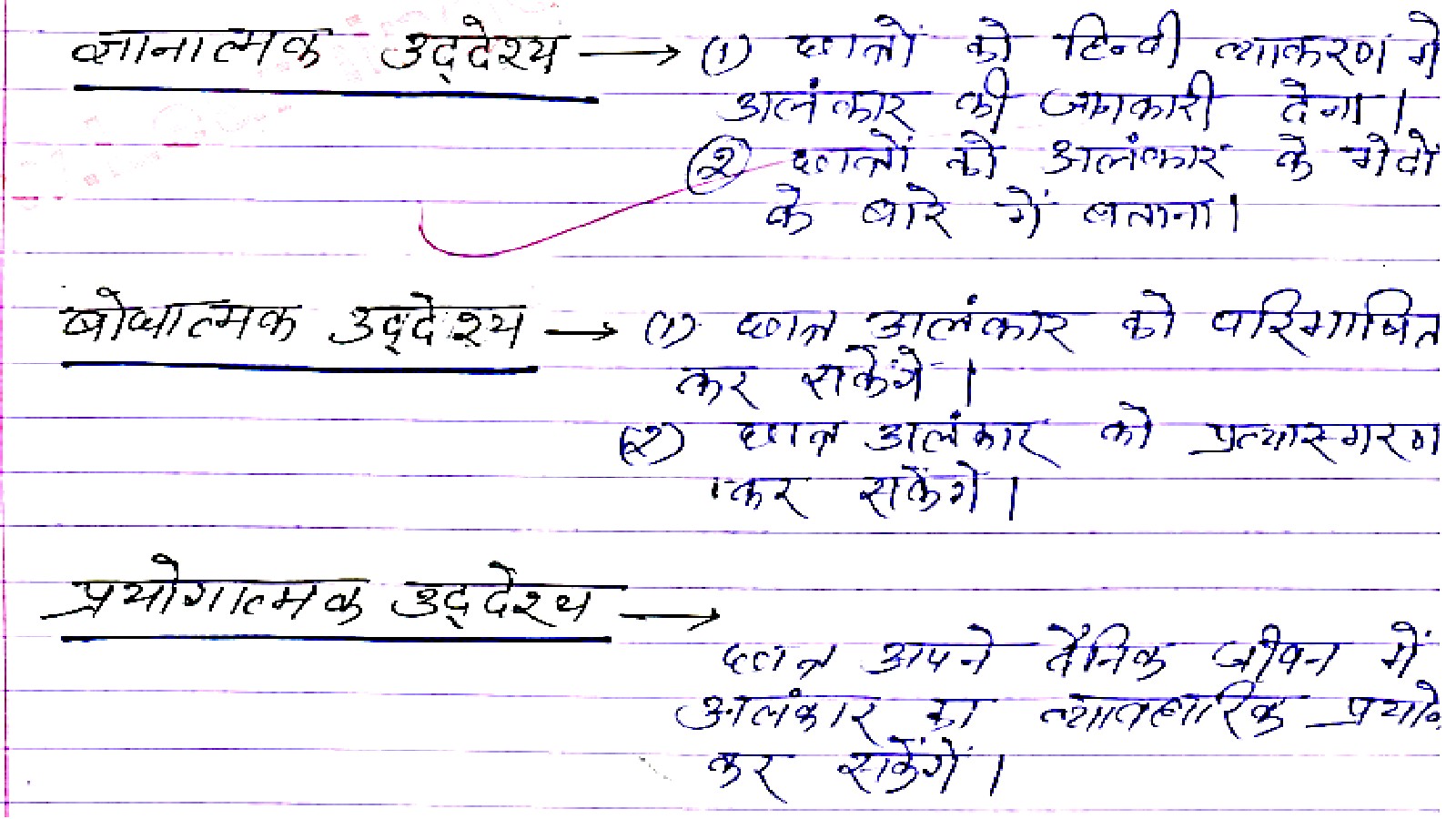Comprehensive Lesson Plan Guide for Middle School Teachers
(Grades 6-8) in Punjab
I. What is a Lesson Plan?
A lesson plan is a structured blueprint that
divides a chapter into teachable units (topics), each designed for a single
classroom period (typically 35–45 minutes). It provides a step-by-step
framework for delivering content effectively, ensuring alignment with
curriculum goals and student needs.
II. Purpose and Importance
1.
Direction & Focus:
o Guides
teaching by defining specific learning objectives.
o Prevents
deviation from core concepts.
2.
Classroom Management:
o Helps
address individual learning differences and maintain discipline.
o Optimizes
time utilization.
3.
Systematic Goal Achievement:
o Breaks
down syllabus into achievable daily targets.
4.
Cognitive Development:
o Promotes
logical sequencing of ideas and critical thinking.
5.
Resource Preparedness:
o Identifies
teaching aids and activities in advance.
Key Analogy: Like an engineer’s blueprint for
a building, a lesson plan ensures the "construction" of knowledge is
robust and purposeful.
III. Essential Components of a Lesson Plan
(Follow this structure for every topic)
1.
General Information
o School
name, teacher’s name, date, grade (6–8), section, subject, period duration.
o Topic:
Specific unit title (e.g., "Photosynthesis," "Algebraic
Expressions").
2.
General Objectives
o Broad
subject-based goals (e.g., Science: "Develop
scientific temperament"; Social Studies: "Understand
historical causality").
3.
Specific Objectives
o Measurable
outcomes using action verbs (e.g., "Students will identify parts
of a cell," "Students will solve linear
equations").
o Align
with PSEB (Punjab School Education Board) competencies.
4.
Teaching Aids
o Visual:
Charts, models, maps, diagrams.
o Digital:
PPTs, videos, simulations.
o Basic:
Blackboard, chalk, flashcards.
5.
Previous Knowledge Testing (PKT)
o 2–3
diagnostic questions to activate prior learning (e.g., "What do
plants need to grow?" before teaching photosynthesis).
6.
Introduction
o Hook
students with real-world links, stories, or probing questions (e.g.,
"Why do leaves change color in autumn?").
o End
with a problem statement to ignite curiosity.
7.
Statement of Objectives
o Clearly
announce lesson goals (e.g., "Today, we’ll learn how plants make
food").
8.
Teaching Method
o Grade
6–8 Strategies:
§ Inquiry-based
learning
§ Cooperative
group work
§ Demonstration
(e.g., science experiments)
§ Role-play
(e.g., historical events)
9.
Presentation
o Divide
content into 3–4 key teaching points (e.g., for "Water
Cycle": Evaporation → Condensation → Precipitation).
o Per
Point:
§ Developmental
Questions: Stimulate analysis (e.g., "What happens when water
heats?").
§ Teacher’s
Explanation: Simplify complex ideas.
§ Comprehension
Checks: 1–2 quick questions (e.g., "Define evaporation in your
words").
10. Blackboard
Work
o Organized
summaries: Main terms, flowcharts, diagrams.
o Timeline:
Update after each teaching point.
11. Observation
o Circulate
the room to ensure students are note-taking/participating.
12. Evaluation
o 5–7
competency-based questions (avoid repetition from comprehension
checks):
§ Example:
"Explain how deforestation affects the water cycle."
13. Homework
o Reinforce
learning (e.g., "Draw a water cycle diagram" or "Interview a
family member about traditional water conservation methods").
o Review
next day for feedback.
IV. Practical Guidelines for Punjab Classrooms
1.
Punjab-Specific Adaptations:
o Use
local examples (e.g., agriculture links in science; Punjab’s freedom fighters
in history).
o Address
multilingualism: Simplify English terms, encourage peer explanations in
Punjabi.
2.
Time Management:
o Allocate
minutes per section (e.g., PKT: 5 mins; Presentation: 20 mins).
3.
Inclusive Strategies:
o Mixed-Ability
Groups: Pair advanced learners with peers needing support.
o Differentiated
Tasks: Tiered assignments (e.g., L1: Label cell parts; L2: Explain
functions).
4.
Teaching Aid Innovations:
o Low-cost
aids: Clay models, seed germination kits, local maps.
o Digital
tools: PSEB’s e-learning resources (e.g., podcasts on Punjabi literature).
5.
Evaluation Design:
o Blend
formative (quizzes, observations) and summative (end-of-topic tests).
o Sample
PSEB-aligned question: "Analyze the impact of British land revenue
policies on Punjab’s farmers."
V. Common Pitfalls to Avoid
- ❌ Ignoring
PKT: Leads to disengaged students.
- ❌ Overloading
Content: Stick to 3–4 key points per period.
- ❌ Neglecting
Blackboard: Visual organization aids retention.
- ❌ Generic
Objectives: Tailor goals to topic and grade level.
VI. Sample Lesson Plan Snippet
Topic: "Photosynthesis" (Grade 7
Science)
- Specific
Objective: "Students will sequence the steps of
photosynthesis."
- Teaching
Aids: Live plant, chloroplast diagram, sunlight simulation (torch).
- Developmental
Q: "Why can’t humans make food like plants?"
- Blackboard:
Flowchart: Sunlight → Chlorophyll → CO₂ + Water → Glucose + Oxygen.
- Homework:
"Collect leaves showing different stages of chlorophyll
production."
VII. Conclusion
An effective lesson plan is the backbone of
impactful teaching. By blending PSEB guidelines with pedagogical
creativity, Punjab’s teachers can foster engaged, critical thinkers ready for
21st-century challenges.
Final Tip: Revisit and refine plans annually based on
student performance and feedback!
Developed in alignment with PSEB’s Middle School
Curriculum Framework (2023)
Comprehensive Guide to Classroom Lesson Observation for
Pupil Teachers (Grades 6-8
I. The Purpose of Lesson Observation
Peer observation is a powerful professional
development tool that enables teachers to:
- Critically
analyze teaching methodologies
- Identify
student engagement patterns
- Refine
instructional design through collaborative feedback
- Develop
evidence-based teaching practices aligned with PSEB standards
"Observation is the microscope through which we
examine the invisible mechanics of effective teaching."
II. Pre-Observation Preparation
1. Collaborative Briefing
- Discuss
lesson objectives with the observed teacher
- Review
lesson plan components:
- Specific
learning outcomes
- Planned
teaching aids
- Time
allocation per activity
2. Observation Focus Areas
- Select
2-3 priority dimensions (e.g., student engagement, questioning techniques)
3. Tool Preparation
- Create
customized observation checklists (see Section IV)
- Secure
seating chart for student interaction mapping
III. Key Observation Dimensions & Punjab-Specific
Indicators
(With Evaluation Rubrics)
|
Dimension |
Effective Indicators |
Punjab Classroom Evidence |
|
1. Objective Clarity |
- Objectives stated in student-friendly language |
"Today we'll calculate crop yields using algebraic
equations" (Math) |
|
2. Content Appropriateness |
- Matches grade-level competency |
Using Punjab rainfall data in water cycle lesson (Science) |
|
3. Teaching Methods |
- Varied techniques (25% lecture, 50% activity, 25%
discussion) |
Combining Punjabi analogies with English terminology |
|
4. Teaching Aids |
- Authentic/local materials |
Agricultural tools samples in "Soil Types"
lesson |
|
5. Student Participation |
- 80%+ students engaged |
Girls leading group experiments in rural schools |
|
6. Classroom Management |
- Smooth transitions |
"3-clap attention" technique for large classes |
|
7. Reinforcement |
- Summary by students |
"Explain photosynthesis using wheat field
example" |
|
8. Assessment |
- Immediate error correction |
Bloom's taxonomy questions from recall to analysis |
|
9. Time Management |
- Pacing matches plan |
5-minute flexibility for math problem-solving |
|
10. Board Work |
- Structured visual organization |
Step-by-step solution of geometry proofs |
IV. Observation Tools & Documentation
A. Narrative Observation Protocol
markdown
[10:15] Hook Activity: Teacher showed video of Sutlej River
flooding
→ Student reaction: 22/30 leaned forward, audible gasps
[10:20] Group Work: "Predict flood impacts on
Amritsar"
→ Group 3 (boys only) off-task; teacher redirected with
guiding Q
[10:30] Board Work: Clear flowchart of flood causes
→ Used blue chalk for water-related elements (visual
cue)
B. Quantitative Checklist
text
❏ Objectives displayed? ✓
❏ 3+ teaching methods used? ✓
(Video, Q&A, Case Study)
❏ Teaching aids accessible? ✗
(Projector focus issues)
❏ 70%+ students responded? ✓
❏ Summary by students? ✓
(2 volunteers)
V. Post-Observation Feedback Framework
1. The SBI Model (Situation-Behavior-Impact)
"When you used the cooperative learning structure
(Situation), all groups completed their tasks (Behavior), resulting in 95%
participation (Impact)."
2. Punjab-Specific Feedback Starters
- "The
use of [local example] helped students connect..."
- "Consider
adding Punjabi keywords for [concept]..."
- "For
larger classes, try [differentiation strategy]..."
3. Growth-Oriented Language
- Strengths:
"Your questioning technique improved critical thinking when..."
- Growth
Areas: "Students struggled with __; try scaffolding with..."
- Action
Plan: "For next lesson, implement __ and we'll observe __"
VI. Common Punjab Classroom Scenarios & Solutions
|
Scenario |
Observation Focus |
Recommended Strategy |
|
Mixed-ability students |
Differentiation effectiveness |
Tiered assignments by learning level |
|
Limited digital access |
Alternative resource use |
Low-cost models (clay, local materials) |
|
Multilingual comprehension gaps |
Language scaffolding |
Key terms in Punjabi + English |
|
Large class size (50+) |
Classroom management systems |
Peer monitoring + station rotation |
VII. Ethical Observation Practices
- Confidentiality:
Share notes only with observed teacher
- Objectivity:
Record facts ("7 students didn't respond"), not judgments
- Reciprocity:
Alternate observer/observee roles monthly
- Cultural
Sensitivity: Respect local norms (e.g., gender interaction patterns)
"The best observations build bridges, not audit
reports."
VIII. Sample Observation Summary Report
Strengths:
- Masterful
storytelling of Jallianwala Bagh incident (100% engagement)
- Innovative
"protest poster" activity connected to artistic traditions
- Board
timeline clarified chronological relationships
Growth Opportunities:
- Provide
sentence starters for hesitant English speakers
- Add
primary sources (e.g., Bhagat Singh's letters)
- Allocate
time for Q&A after video segments
Impact Evidence:
- 24/30
students accurately explained Rowlatt Act in exit tickets
- 5
groups created historically accurate protest slogans
Final Tip: Conduct quarterly calibration
sessions where teachers co-analyze lesson videos to standardize
observation criteria across your school!
VIII. Sample Observation Summary Report
|
Dimension |
Observation Evidence |
Effectiveness Rating |
|
1. Objective Clarity |
Stated: "Today, we’ll identify 4 stages of
photosynthesis using wheat crops in Punjab farms." |
★★★★★ (HE) |
|
2. Content Appropriateness |
Linked chloroplast function to Punjab’s rice paddies;
avoided overly technical terms. Matched PSEB Grade 7 competency levels. |
★★★★☆ (E) |
|
3. Teaching Methods |
Used: |
★★★★☆ (E) |
|
4. Teaching Aids |
Used: |
★★★☆☆ (D) |
|
5. Student Participation |
22/30 engaged actively; |
★★★☆☆ (D) |
|
6. Classroom Management |
"Silent signal" (raised hand) halted side
conversations; |
★★★★★ (HE) |
|
7. Reinforcement |
Summary: 2 students re-explained process using cotton
field example; |
★★★★☆ (E) |
|
8. Assessment |
Exit tickets: 3-tiered questions: |
★★★★★ (HE) |
|
9. Time Management |
Started/ended punctually; |
★★★★☆ (E) |
|
10. Board Work |
Color-coded flowchart: |
★★★★★ (HE) |
Key
- HE:
Highly Effective (Exceeds expectations)
- E:
Effective (Meets expectations)
- D:
Developing (Needs improvement)
Constructive Feedback
1.
Teaching Aids (D):
o Suggestion: Backup
low-cost aids (e.g., seed germination kit) for tech failures.
2.
Student Participation (D):
o Suggestion: Use
randomized name sticks to ensure gender-balanced responses.
3.
Teaching Methods (E):
o Growth
Opportunity: Add role-play (e.g., "Be a glucose molecule!").
"Your board work and real-world Punjab examples made
complex concepts tangible. Next step: Balance participation through structured
group roles."
*Effectiveness Scale: HE = 5★ | E = 4★ |
D = 3★ | I = 1–2★*
The Transformative Power of Reflective Journals: A Guide for
Punjab’s Middle School Teachers (Grades 6-8)
I. Why Reflective Journals?
Reflective journals are metacognitive tools that
empower teachers to:
- Critically
analyze lesson effectiveness
- Document
student learning patterns
- Personalize
pedagogical approaches
- Transform
teaching practice through evidence-based insights
II. Designing Your Reflective Journal: A 4-Phase Framework
Phase 1: Pre-Lesson Preparation
1.
Anticipatory Reflection
o Guiding
Prompts:
§ "What
misconceptions might students have about today's topic (e.g., algebraic
variables)?"
§ "How
will I connect photosynthesis to Punjab's wheat fields?"
o Punjab
Context Example:
"Before teaching 'Water Conservation,' I’ll survey
students about tube-well usage in their villages."
2.
Resource Alignment
o Map
teaching aids to learning objectives (e.g., "Use Punjab rainfall
charts for climate lessons")
Phase 2: During Lesson (Live Documentation)
|
Time |
Observation Focus |
Sample Journal Entry |
|
10:15 AM |
Student Engagement |
*"Group 3 (back row) disengaged during diagram
drawing - switched to clay model activity"* |
|
10:30 AM |
Conceptual Breakthrough |
"Amanjot finally understood fractions
using paratha division analogy" |
|
10:45 AM |
Unexpected Challenge |
"Power outage disrupted video; improvised with
shadow puppets for light reflection demo" |
Phase 3: Post-Lesson Deep Reflection
Structured Prompts (Adapt for Punjab Context):
1.
Content Delivery
o "Did
my soil erosion examples (e.g., Shivalik hills) resonate?"
2.
Student Response
o "Which
students struggled with English science terms? Should I add Punjabi labels next
time?"
3.
Pedagogical Effectiveness
o "Did
the 'Green Revolution debate' foster critical thinking as intended?"
4.
Emotional Temperature
o "Why
did Priya’s group become defensive during peer feedback?"
5.
Actionable Insights
o "Differentiate
homework: Advanced students survey crop patterns; others draw water cycle
diagrams."
Phase 4: Weekly Synthesis
- Pattern
Tracking Template:
markdown
| Week | Recurring Issue | Intervention Tested | Outcome |
|------|-----------------------|------------------------|------------------|
| 1 | Girls
avoiding labs | Assigned female group
leaders | Participation ↗ 25% |
| 2 | English
anxiety | Bilingual glossaries | Hand-raising ↗ 40% |
III. Punjab-Specific Implementation Strategies
A. Journaling Formats
|
Format |
Ideal For |
Punjab Example |
|
Digital Diaries |
Tech-equipped schools |
Audio notes about student responses to Partition history |
|
Sketch Journals |
Visual learners |
Drawings of canal irrigation systems |
|
Bilingual Logs |
Multilingual classrooms |
Mix of Punjabi reflections + English terms |
B. Collaborative Practices
1.
Peer Triads
2.
SCERT Reflection Circles
o Share
entries about rural teaching challenges at district training workshops
IV. Transforming Entries into Action
Sample Reflection Cycle
→ Action Plan:
1.
Create cooking-based science vocabulary wall
2.
Film grandmothers explaining local science
proverbs
3.
Design "kitchen experiments" homework
V. Overcoming Common Challenges
|
Challenge |
Solution |
|
"No time for journaling" |
Dedicate 7 minutes post-lesson using bullet points |
|
"Don’t know what to write" |
Use prompt cards: "One success today... One
puzzle..." |
|
"Fear of criticism" |
Keep initial journals private; share excerpts later |
VI. Evidence of Impact
Punjab Case Study (Grade 8 Science Teacher):
- Baseline: 45%
avg. score in energy concepts
- After
3 months of journaling:
- Identified
visual learning gap through journal patterns
- Created
Punjab electricity grid diagrams
- Result: Scores
↗
72%; student diagrams featured at Patiala Science Fair
VII. Start Today: Your Reflective Toolkit
1.
Essential Prompts
o "What
surprised me today?"
o "Which
student’s 'aha' moment mattered most?"
o "How
did I adapt to unexpected moments?"
2.
Digital Aids
o SCERT
Punjab’s e-Journal App (offline compatible)
o Voice-to-text
tools for rural teachers
Final Wisdom: "Your journal is not an
evaluation dossier – it’s a conversation with your evolving teacher-self."
The Reflective Practitioner's Journal: Transforming Teaching
Practice in Middle Schools (Grades 6-8)
I. The Power of Self-Reflection in Teaching
Reflective journals are catalytic tools for
professional growth, enabling teachers to:
- Systematically
analyze lesson effectiveness
- Identify
invisible patterns in student learning
- Transform
classroom practice through evidence-based adjustments
- Develop
pedagogical self-awareness aligned with PSEB standards
"The unexamined lesson is a lost opportunity for
mastery."
II. Comprehensive Reflective Journal Framework
(Adaptable Template for Punjab Teachers)
A. Lesson Metadata
|
Field |
Details |
|
Date |
15 Oct 2024 |
|
Class |
Grade 7 |
|
Subject |
Science |
|
Unit |
Natural Resources |
|
Topic |
Water Conservation in Punjab |
|
No. of Students |
42 (22 boys, 20 girls) |
|
Duration |
45 minutes |
B. Behavioral Objectives Analysis
|
Objective |
Achieved? |
Reasons |
Improvement Strategies |
|
*Students will list 5 water-saving techniques* |
Partially |
Only 3 techniques discussed |
Add farm irrigation methods next lesson |
|
Demonstrate drip irrigation model |
No |
Model malfunctioned |
Test equipment pre-lesson |
|
Analyze Punjab's groundwater crisis |
Yes |
Used local case studies |
Maintain real-world connections |
Punjab Context Note: "Connect objectives
to agricultural realities – 78% of students come from farming families."
C. Teaching Method Evaluation
|
Criteria |
Analysis |
Refinement Plan |
|
Appropriateness |
Lecture dominated (70%) vs. PSEB-recommended
activity-based learning |
Shift to station rotation: |
|
Mental Level Match |
Vocabulary too advanced for ESL learners |
Create bilingual glossary (Punjabi-English) |
|
Improvement Scope |
Insufficient higher-order questioning |
Embed Bloom's taxonomy prompts: |
D. TLM & Student Engagement Audit
|
Element |
Effectiveness |
Action Steps |
|
TLM Appropriateness |
Chart effective; malfunctioning drip kit caused
disengagement |
• Pre-test all equipment |
|
Activity Design |
Poster-making worked well; group roles undefined |
• Assign specific roles (Researcher, Artist, Presenter) |
|
Participation Rate |
65% active (Girls 80% ↗ Boys 50% ↘) |
• Implement "think-time" before responses |
|
Participation Boost |
Shy learners avoided debate station |
• Introduce "talking sticks" |
E. Teaching Skills Self-Evaluation
|
# |
Skill |
Evidence |
Refinement Plan |
|
1 |
Blackboard Work |
Color-coded diagram but handwriting illegible from back |
Practice block letters; use stencils for diagrams |
|
2 |
Prior Knowledge Linking |
Connected to home water usage but missed farm connections |
Start with: "How does your family conserve
water during paddy season?" |
|
3 |
Presentation |
Rushed through groundwater data slides |
Chunk content: 15 mins theory → 20 mins activity |
|
4 |
Questioning |
80% recall questions; missed application queries |
Prep layered questions: |
|
5 |
Student Questioning |
Only 3 student questions; discouraged by time pressure |
Implement "Wonder Wall" for anonymous questions |
|
6 |
Class Control |
Lost focus during model failure; restored with clapping
rhythm |
Develop 3 non-verbal signals (lights, flags, hand signs) |
|
7 |
Interest Maintenance |
High engagement during local examples; dropped during
definitions |
Convert terms to Punjabi analogies (e.g., "Aquifer
= underground bail") |
III. Punjab-Specific Reflective Prompts
Post-Lesson Critical Questions:
1.
"Did my examples resonate with
rural/urban student experiences?"
2.
"How did I accommodate multilingual
learners today?"
3.
"Which SCERT resource could enhance
tomorrow's lesson?"
4.
"What agricultural connections did I
miss?"
Weekly Reflection Focus:
"Track participation patterns: Are landlord-farmer
student dynamics affecting group work?"
IV. Transforming Reflection into Action
Sample Growth Cycle:
V. Digital Tools for Punjab Teachers
|
Tool |
Application |
|
SCERT e-Diary App |
Voice-to-text journaling in Punjabi |
|
Google Classroom |
Digital reflection portfolios |
|
Punjab EdCloud |
Share successful strategies across districts |
Pro Tip: "Photograph your board work
daily – reveals presentation patterns over time."
VI. Evidence of Impact
Amritsar Pilot Study (2024):
- 47
teachers using journals for 3 months
- Results:
- Student
engagement ↗ 35%
- Lesson
objective achievement ↗ 28%
- 92%
teachers reported improved self-awareness












